Australia’s Endangered Wildlife
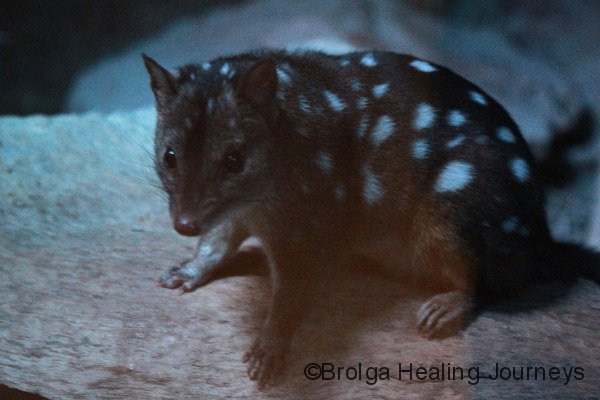
INTRODUCTION
Where do you start on a topic like this? When Nirbeeja suggested this as a good theme for a new post, I must admit to feeling completely overwhelmed. “Endangered wildlife” isn’t the theme for a post, it’s a lifetime’s work. I soon realised that my initial reaction symbolised how we all feel about this issue – basically that it’s too big to deal with. As a result we pretend it isn’t there and move on to something easier, or go see a movie, or eat some chocolate….or do whatever it is that we do to avoid reality.
Of course, if we all did that, many Australian species of marsupial, bird, reptile and amphibian, not to mention plants, would disappear in the blink of an eye. In fact many already have, never to be seen again. The delicate Lesser Bilby, once seen in the central desert regions, is gone. Wiped out. Extinct. Call it what you like, it is now but a memory. When you see a real, live Greater Bilby, its bigger and more robust cousin, although it too is a delicate, fragile creature under threat of extinction, you realise that the Lesser Bilby stood no chance at all against efficient feral predators and environmental degradation. Unfortunately the Lesser Bilby isn’t alone. As I wrote in the introduction to the earlier marsupials post on this site, Australia holds the unfortunate record for mammal extinctions in the modern world. Let’s not add to that record if we can help it!
Why bother, you might ask, and I must admit it is easy to grow pessimistic about the whole issue. Well, once these creatures are gone, obviously we will never get to see them again, but we also remove the opportunity for our children, grandchildren and every generation beyond to see them. I think we have a duty to future generations to leave as many species on our planet as we can. At another level, every species forms an integral link within the environment, so each time we remove one species, other species will be adversely affected. We still have much to learn about the subtleties and intricacies of nature, so can only guess as to the overall impact of every additional extinction on the whole environment.
So, I wondered, how could I write a post on endangered wildlife and not simply fill everyone with despair, gloom and guilt, and make them flee for solace to their Play Station 2 or a re-run of Sex and the City?
Let’s start by looking at some of the species under threat. I hope to achieve two things here – firstly to make people more aware of these special creatures and their unique features, and secondly to show that their struggles are representative of challenges facing the ecosystems in which they live. Environmentalists sometimes refer to this as the iceberg effect – that is, that while we may be aware of one or two endangered species within an ecosystem, in fact all members of the ecosystem face similar challenges and pressures.
Then we will have a sobering look at the reasons our wildlife is under threat. These reasons are many and varied, and often inter-related. Fortunately, while the problems they pose are difficult, most are not insurmountable, and they certainly can be managed so as to lessen their impact on wildlife.
And, finally, I hope to end on a positive note, examining the many things we can do in our everyday lives to help, and also to let you know of the wonderful work being done around Australia by some passionate and energetic individuals and organizations, doing their level best to give these creatures a future.
ENDANGERED AUSTRALIAN WILDLIFE SPECIES
The list of Australian wildlife species classified as endangered is long and growing longer. Unfortunately, more species are added to the list than are removed from it. There is a positive note however – much work is being done to protect these creatures. Breeding programs are underway, and habitat protection in national parks and through private purchase of wilderness areas is easing the pressure on these species.
As well as focussing on endangered species, we should also bear in mind that many other species have declining populations; it is just that their numbers have not yet fallen to the critically low threshold where they are classified as endangered. This is supported by recent counts undertaken by Birds Australia (BA), an organisation of birdlovers and conservationists, which among other things monitors bird populations across our country. BA has noted serious population declines in recent years even in many species previously considered common, such as the Willy Wagtail in NSW and the Peewee.
The following is a list of some of our wildlife species, listed as “endangered”, “threatened” or considered in serious decline. I wondered whether I was being over-zealous in including the species I did, but having checked, learned that many more could have been listed. So here are some:
Marsupials
Greater Bilby
Rufous Hare Wallaby (also called the Mala)
Brush Tailed Bettong
Burrowing Bettong
Red Tailed Phascogale
Western Ring-tailed Possum
Western Quoll (in fact, Quolls of all descriptions)
Yellow Footed Rock Wallaby
Banded Hare Wallaby
Tammar Wallaby
Bridled Nailtail Wallaby
Brush-tailed Mulgara
Northern Quoll
Southern Ningaui (a tiny carnivorous marsupial from inland Australia)
Yellow Bellied Glider
Northern Bettong
Brush-tailed Marsupial Rat (also called the Kowari)
Short-Eared Rock Wallaby
Spectacled Hare Wallaby
Lumholtz’s Tree Kangaroo
Tasmanian Devil
Northern Marsupial Mole
Southern Marsupial Mole
When you think about it, the above list includes a large proportion of Australia’s marsupials. The only ones doing well are the Eastern, Western and Red Kangaroos, and the Wallaroo. Those are faring better because they have benefitted from our focus on creating grazing land for sheep and cattle. They are large enough not to be preyed upon by feral cats and foxes, unlike many of their smaller marsupial cousins.
Other endangered mammals
Spinifex Hopping Mouse
Dusky Hopping Mouse
Greater Stick Nest Rat
Plains Rat
Grey-Headed Flying Fox
Ghost Bat
Birds
Night Parrot
Major Mitchell Cockatoo
Brolga
Gouldian Finch
Orange Bellied Parrot
Black Eared Miner
Southern Cassowary
Red Goshawk
Malleefowl
Rufous Owl
Masked Owl
Purple Crowned Fairy Wren
Eyrean Grasswren
Grey Grasswren
Sooty Owl
Red-Browed Treecreeper
Hall’s Babbler
Square-Tailed Kite
Brown Falcon
Bourke’s Parrot
Others
Corroboree Frog
Great Desert Skink
We have come across some of these creatures during our travels, and consider ourselves fortunate to have seen them, whether that was by way of a thrilling encounter in the wild, or in special breeding enclosures. The latter, while perhaps not as exciting as a wilderness encounter, were inspiring in that they showed that there remains hope for these creatures.
Let’s look at a few of our endangered species in more detail:
ENDANGERED MARSUPIALS
THE GREATER BILBY
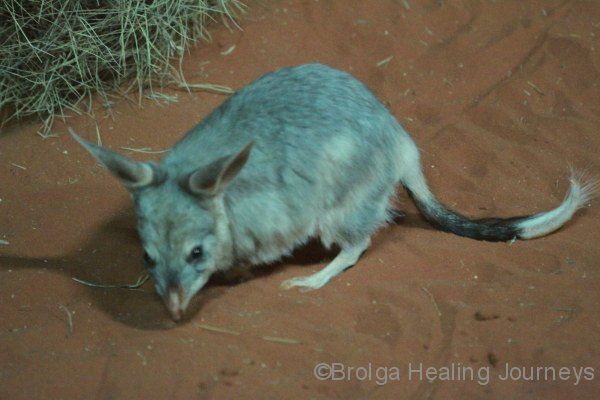
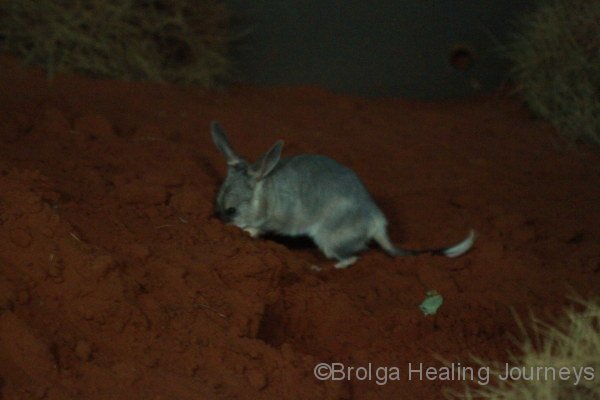
Nothing quite prepares you for your first look at a Bilby. Sure, most of us have been made aware of these delightful creatures through the campaign to replace the Easter Bunny with the Easter Bilby in Australia, to help raise funds to save them from extinction.
But a real live Greater Bilby resembles nothing else in nature. It has great big hairless ears, a pointy snout, spindly looking legs and a striking black and white tail. It almost looks as though it has been patched together from parts of other creatures! And it was somewhat larger than we expected, about the size of a full-grown rabbit; an adult male can weight up to 2.5kg.
They have poor vision but their hearing and sense of smell are both exceptional. Large ears add to their hearing, but also help the Bilby to cool down in the extreme heat of central and outback Australia. They have strong front limbs with clawed toes which are used for burrowing. Their hind limbs are used for hopping. The tail of the Greater Bilby is black from its base to around the halfway point, from which it turns a bright white. These white tips are easy to see at night, even for the Bilby with its poor eyesight, and Bilbies are able to determine the presence and location of others by their tail tips. Because it is a burrowing marsupial, the Greater Bilby, in common with the wombat, has evolved a backwards-facing pouch for its young; otherwise the pouch would fill up with dirt or sand as it burrowed, suffocating the young. As a result, young Bilbies cannot look out of the pouch and observe the plants being eaten by their mother, which is the case with Kangaroo and Wallaby joeys. To learn about feeding, the young Bilby leaves its mother’s pouch and follows close at heel, using its mother’s highly visible white tail tip as a banner to follow. These white tips were also used by Aboriginal elders for decoration.
Greater Bilbies, and their smaller relative, the Lesser Bilby, which was last seen in South Australia in 1931 and now presumed extinct, were once common in the sandy desert regions of inland Australia. The Greater Bilby is now only found wild in some remote outback areas of Western Australia, the Northern Territory, and a small area in south western Queensland.
Early in the 20th century, the Greater Bilby was hunted for its fur, poisoned, and caught in rabbit traps. Thankfully, those practices ceased long ago, but now the Greater Bilby is preyed upon by feral cats and foxes, and faces competition for habitat and food from rabbits and cattle.
Many efforts are underway to save this unusual and beautiful marsupial. Numerous predator-free enclosures have been set up to allow breeding and recovery of Bilby numbers. Bilbies have also been released in the Francois Peron National Park in Western Australia after an aggressive fox-baiting campaign.
The Greater Bilby is our largest member of the Bandicoot family, and its plight is representative of the problems facing all other bandicoots.
Next time you purchase chocolate at Easter, make sure it’s an Easter Bilby, and check the label to ensure the profits will be used to support these little fellows.
THE RUFOUS HARE WALLABY, OR MALA
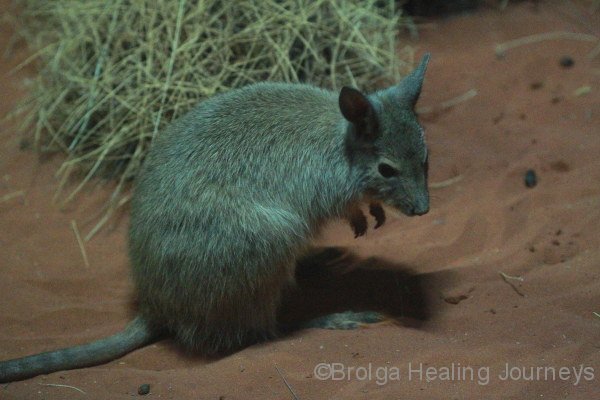
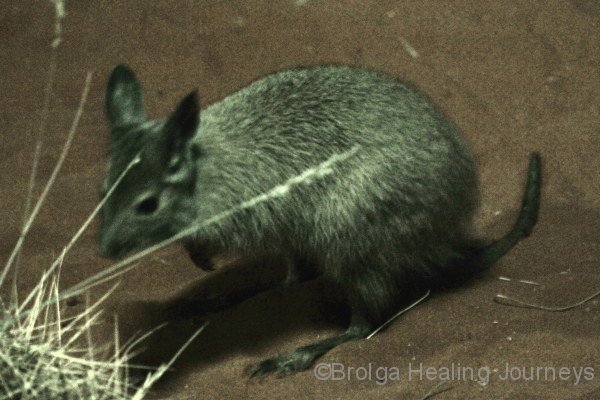
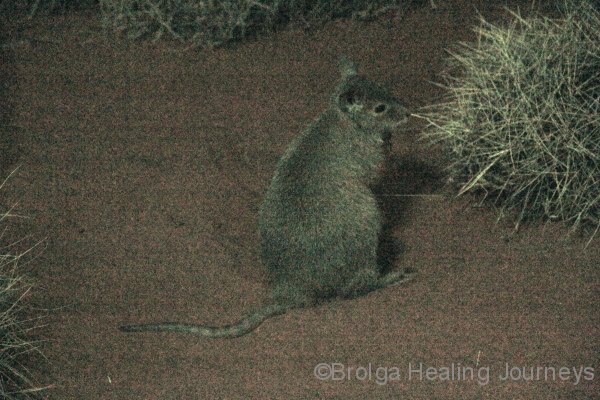
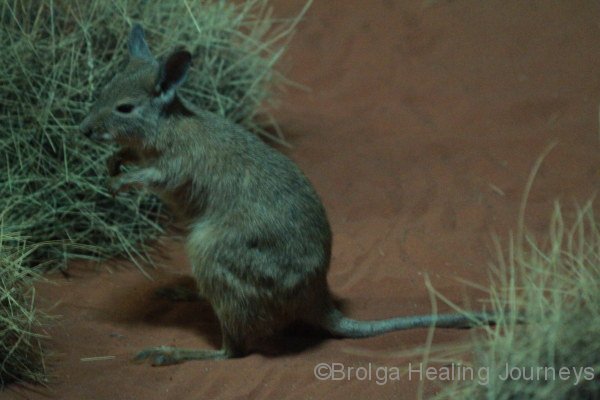
The Mala, one of our smallest Wallabies, was once frighteningly close to extinction, with its numbers dropping as low as 27 in the 1990s, before captive breeding programs led to their gradual recovery. That number, 27, chills me to the bone; it is hard to think of a species getting much closer to extinction and then recovering.
Unfortunately, there are now no Malas to be found hopping around in the wilderness on mainland Australia. Nowadays, you will only see Malas in predator-proof enclosures. Currently, they are housed near Uluru and Watarrka (Kings Canyon) and in the Alice Springs Desert Park, where they are being bred successfully. They were also released on the Bernier and Dorre Islands off the Western Australian coast, islands free from predators, in efforts to save the species. Their numbers on those islands are growing slowly. Their combined numbers from all regions are now estimated to be several hundred, an improvement on 27, but still with a long way to go.
The Mala is around 30cm tall, a gorgeous creature covered in thick rufous fur, which becomes paler underneath. These nocturnal, agile little marsupials live in sandy desert country where spinifex is common.
They are mainly herbivorous, feeding on grasses, bulbs and sedges, though they are known to partake of the occasional insect or spider.
They become sexually mature at a young age (5 months) and in favourable conditions will breed frequently. Like the kangaroo, the Mala has a special breeding capability, in that it can hold a fertilised egg in suspension until a previous joey has left the pouch, or until conditions are more favourable to allow the young to develop. Amazingly, the Mala can simultaneously produce different types of milk suitable for joeys at different stages of development. This incredible reproductive capacity of the Mala has certainly helped to boost their numbers through captive breeding programs.
If any creature symbolizes the effect of white man on central Australia, it is the Mala. The Mala Dreaming story is central to the lore of Uluru, and Mala Puta (the Mala’s Pouch) is one of the most sacred sites on Uluru. The Mala Dreaming links Uluru with Watarrka. Before white man, the Mala was one of the most abundant marsupials in central Australia, yet it is now not found in the wild. Similarly, our presence has caused untold damage to the culture of the traditional people of the region. I hope to live to see the safe return of the Mala to the wilderness around Uluru and Watarrka, and for the Mala Dreaming to be restored to its full power. Such an event would be immensely healing for the local Aboriginal people.
THE YELLOW-FOOTED ROCK WALLABY
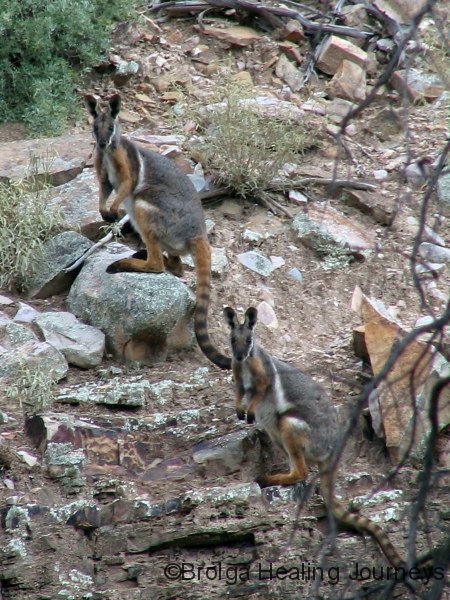
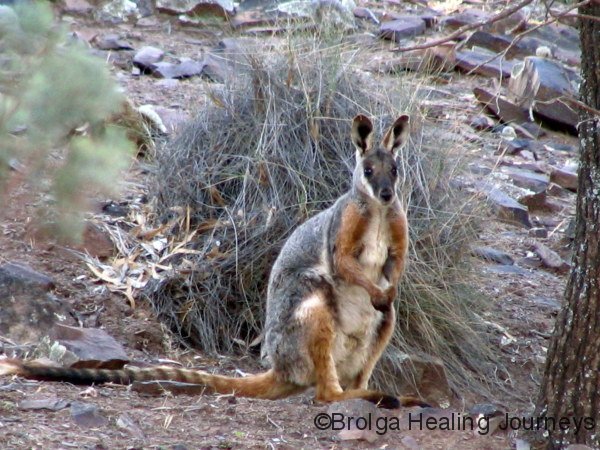
Any sighting of a Wallaby in the wild is very exciting. Unfortunately, all Wallaby species have suffered significant population declines, due to many factors, including predation by feral foxes and cats, competition from feral goats for food, often in drought-stricken marginal habitats, and habitat destruction more generally. But, despite that rather gloomy introduction, there many programs Australia-wide to save our endangered Wallabies.
Our most memorable encounters have been with the endangered Yellow Footed Rock Wallaby. We were fortunate to see two separate colonies in South Australia, both times in fading light as the Wallabies came out from their rocky shelters to feed. The first sighting was in the Mount Remarkable National Park, and the other at Warren’s Gorge near Quorn, in the central Flinders Ranges. These are beautiful creatures, exquisitely coloured, and are able to hop with extreme agility across steep rocky inclines.
The Yellow Footed Rock Wallaby lives in isolated colonies in the Flinders Ranges, in the Gawler Ranges further to the north and in small numbers in Mutawintji National Park and nearby ranges in the north-west of NSW.
We have encountered other Wallabies on our travels, and while they may not all be as stunningly patterned as the Yellow Footed Rock Wallaby, they are all delightful creatures and face similar challenges.
THE WESTERN RINGTAIL POSSUM

The Ringtail Possum is common Australia-wide, but the Western Ringtail Possum, now found only in the south-west of Western Australia, is seriously endangered. Two major factors have contributed to the dramatic decline in their numbers – the loss of habitat through land clearing, and predation by feral foxes.
The Western Ringtail Possum lives in the Peppermint Tree woodlands of WA’s south west, preferring to nest in old hollows within these trees. Unfortunately, many of these trees have been lost through land clearing to make way from the increasing urbanisation of the region. We saw this first-hand during our three month stay in Busselton south of Perth. Peppermint Trees are supposedly protected in the region, yet we saw several cut down nearby to make way for new housing.
With Western Australia’s rather gung-ho approach to development, we hold grave fears for the future of this sub-species.
THE RED-TAILED PHASCOGALE
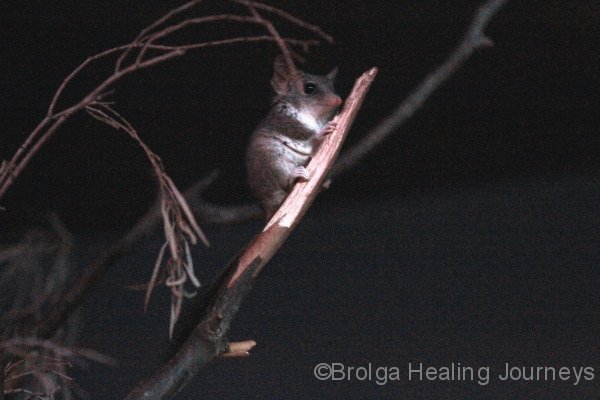
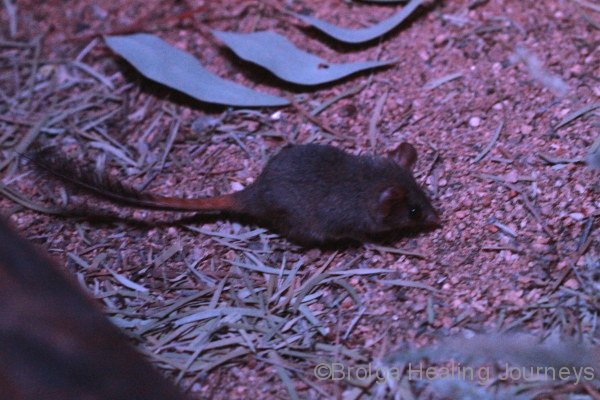
The Red-Tailed Phascogale was once widespread across Australia, but is now restricted to the wheatbelt region of Western Australia. It is a highly animated, small carnivorous marsupial. It is an adept tree climber and is able to leap up to 2 metres between branches, a mighty effort for something its size. It is a nocturnal creature with large eyes, a grey furry body and, as its name suggests, a reddish, almost feathered tail. Like many small inland mammals, it has no need to drink, drawing necessary moisture from its food.
Even in favourable conditions, most males of this species die within their first year. After mating, they are driven out of their customary territory by the pregnant female. The stress of this upheaval, coupled with the energy expended during courting and mating, soon kills most males. (And we human males thought we had it tough!) Females live for around 4 years. In captivity, males kept in isolation after mating live for around three years.
The Red-Tailed Phascogale has becoming endangered for reasons all too common – predation by feral cats and foxes, habitat loss through land clearing for agriculture and logging, and changed fire management regimes.
The Alice Springs Desert Park has a captive breeding program for the Red-Tailed Phascogale, and there are similar breeding programs in South Australia.
THE WESTERN QUOLL, OR CHUDITCH
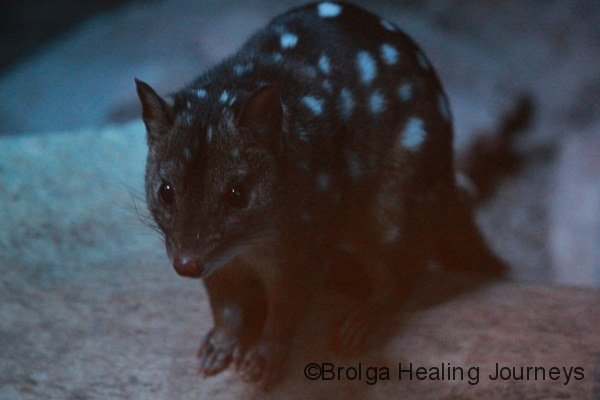
Australia is home to four species of Quoll (also called the native cat), the Northern, the Eastern, the Spotted-Tailed and the Western. With the exception of the Eastern Quoll, which is faring reasonably well in Tasmania (although believed extinct on the mainland), all are under threat.
Despite its name, the Western Quoll was once widespread across the Australian mainland. It lived both in woodland habitats and in sand country, and as such it was the Quoll species found across central Australia. It is now only found in the south west of Western Australia. A range of factors were responsible for its disappearance from much of the country; an all too familiar list I’m afraid. We’ve encountered them all before – habitat loss through land clearing in previously forested regions, predation by feral cats and foxes, and in the desert regions, the loss of the traditional burning practices of the Aboriginals.
The Quoll is a nocturnal carnivore, busiest around dusk and shortly before dawn. They are inquisitive, active and intelligent creatures, with a diet consisting of any small creatures they can catch – insects, lizards, small mammals, spiders, frogs and birds. Although they mainly hunt on the ground, they are adept climbers and are known to raid bird nests. Their beautiful spotted coats provide magnificent camouflage in the dappled light of the forest.
In common with many native marsupials, they obtain most of their water needs from their food, rarely needing to drink. Their ability to slow their metabolic rate and lower their body temperature several degrees during the day, while they are asleep, aided their survival in arid country where food was scarce.
As top of the food chain in the ecosystems in which they lived – the head carnivore – the Quoll was an important indicator of the overall health of those systems. Unfortunately, the disappearance of the Western Quoll from most of its previous territory tells us a sad story as to the damage done to those environments.
There are an estimated 3000 Western Quolls in the wilderness in the south western Jarrah forests of WA. The Perth Zoo once had a captive breeding program, but that has been discontinued. It remains to be seen whether the Western Quoll will be able to be returned to its former territories in the desert regions of Australia, where it is now listed as extinct.
THE BRUSH-TAILED BETTONG, OR WOYLIE
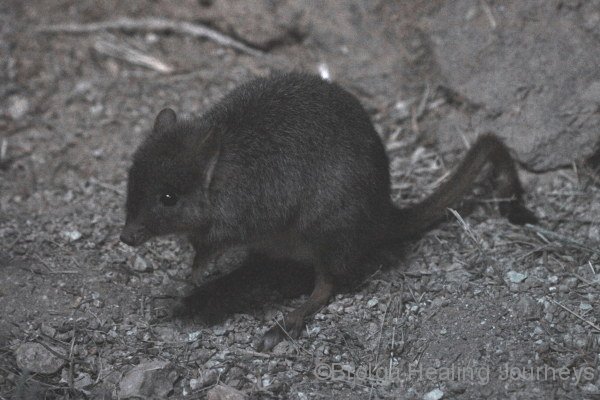
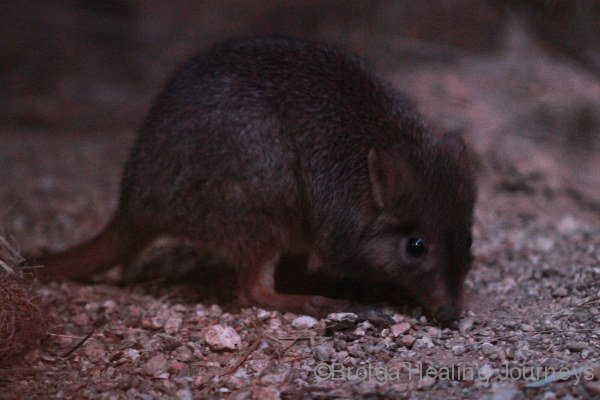
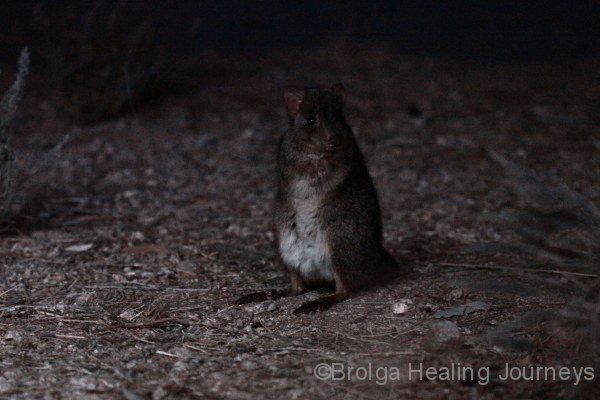
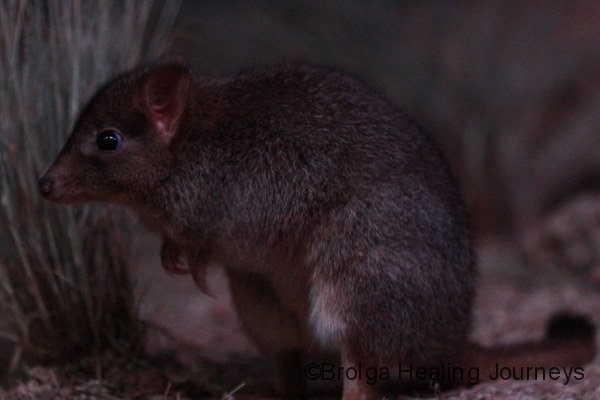
The Bettongs are cousins of the Kangaroos and Potoroos. According to the Aboriginals, and supported by the records of early explorers, the Brush-tailed Bettong was once widespread across Australia south of the tropics, including the central desert regions of Western Australia, and the southern regions of the Northern Territory. Now this creature is found wild only in the south west of Western Australia. It has also been released successfully in the Francois Peron National Park in the Shark Bay region of WA, as part of Project Eden.
The Brush-Tailed Bettong is a small to medium sized marsupial which uses its prehensile tail to hold nesting material. This Bettong builds domed nests in the open forests and woodland areas in which it lives, preferring to inhabit the thick understory which provides shelter and protection from predators.
Although the Brush-Tailed Bettong is classified as herbivorous, it has an unusual diet, mainly consisting of underground fungi dug up by the Bettong as it forages around the forest floor. It also favours mushrooms and native truffles when they are available, and supplements its diet with tubers, bulbs, seeds insects and resin. These Bettongs really are quite remarkable, as their digestive systems have adapted to utilize the bacteria found in fungi to extract the maximum nutrition available from their foods. Their faeces act as a powerful fertiliser, crucial to the health of the forest eco-systems in which they live. As with many native marsupials, the Brush-Tailed Bettong does not need to drink, and nor does it require green plant matter, two reasons why it was able to live in the arid interior of Australia.
We are only now becoming aware of the vital ecological role once played by this species in the semi-arid woodlands of Australia. Each Brush-Tailed Bettong turns over approximately 5 tonnes of soil each year as it forages for food. When we consider that there were millions of these creatures in Australia before European settlement, it becomes obvious that we once had an army of little gardeners caring for our bushland soils. As they dug, the Bettongs turned leaf and plant matter into the soil, speeding up the composting process and improving soil quality. Their digging also aerated soils and improved rainfall absorption, at the same time lessening run-off and nutrient loss. By reducing the amount of dead plant matter on the surface, the Bettong also helped lessen the effect and severity of bushfires. Now the Bettong is restricted to small pockets of south western WA (and special breeding programs elsewhere), so this process has all but stopped. While rabbits dig burrows, they do not turn over soil in the same beneficial way, and in fact compete with Bettongs for territory. Sheep and cattle compact soils with their hard hooves, and therefore exacerbate the problems caused by the loss of Brush-Tailed Bettongs from greater Australia.
The dramatic loss of Brush-Tailed Bettongs across Australia has also led to the decline of native truffles. We now know that the Bettong played a role in the survival and propogation of these truffles; the truffle spores would stick to the Bettongs’ fur and be spread through the woodlands as the Bettongs wandered, and the spores would possibly also be spread in Bettong droppings.
Land clearing for agriculture and grazing, competition from introduced herbivores, and predation by feral cats and foxes, are all responsible for the Brush-Tailed Bettong becoming endangered. Its survival depends upon the conservation of appropriate forest habitat in south west WA, and more effective control of feral predators. The supply of special predator-free environments, such as in the Francois Peron National Park, and the Australian Wildlife Conservancy’s Scotia reserve,will be crucial in the short term.
OTHER ENDANGERED MAMMALS
So far, we have looked at some of our endangered marsupials. Australia is also home to many placental mammals, that is, creatures like humans, where the young develop in a womb rather than a pouch. Many of our placental mammals are also classified as endangered.
THE PLAINS RAT
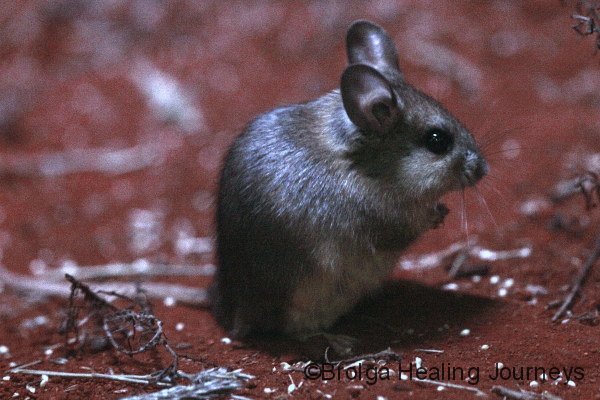
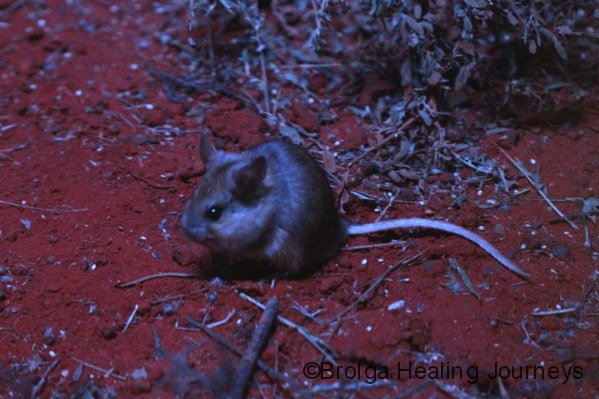
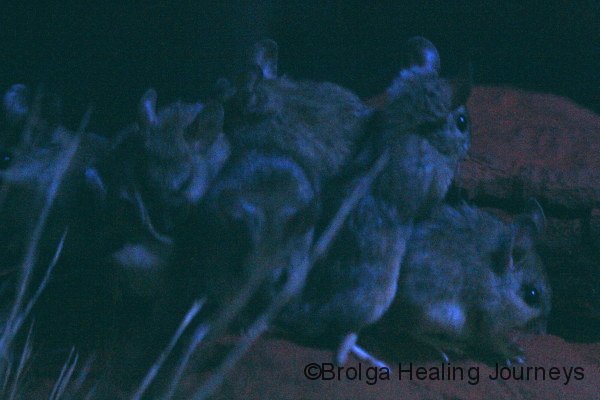
Set aside your preconceptions about rats, and look at this little fellow. Is there a cuter creature on the planet?
This beautiful little rodent once thrived in the deserts of inland Australia, but is now endangered thanks to feral predators and habitat destruction from stock; an all too familiar story for our small mammals. The Plains Rat, a placental mammal like us, is nocturnal, and lives on arid gibber plains, clay pans and sand ridges with low scrub. During the day they sleep in cool shallow burrows. The Plains Rat is herbivorous, and like many of our small mammals from desert regions, can survive without drinking water.
The future of the Plains Rat in the wild is linked to our overall efforts to eradicate feral predators, an extremely difficult task, as you will read below. Similarly, Australia would have to undergo an enormous cultural shift for cattle and sheep numbers to be reduced in inland Australia. As a result, the outlook for this beautiful creature does not look overly optimistic.
The Alice Springs Desert Park has a breeding program for the Plains Rat.
THE GREATER STICK NEST RAT
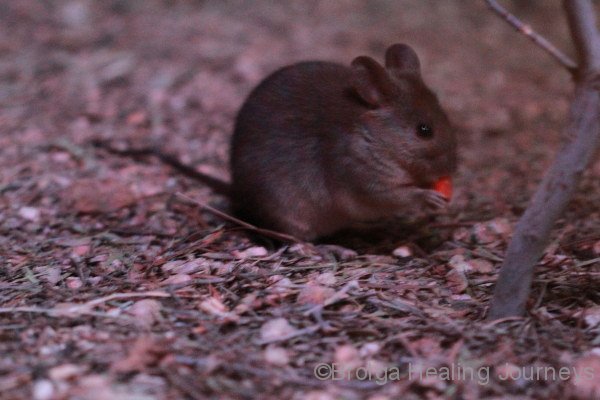
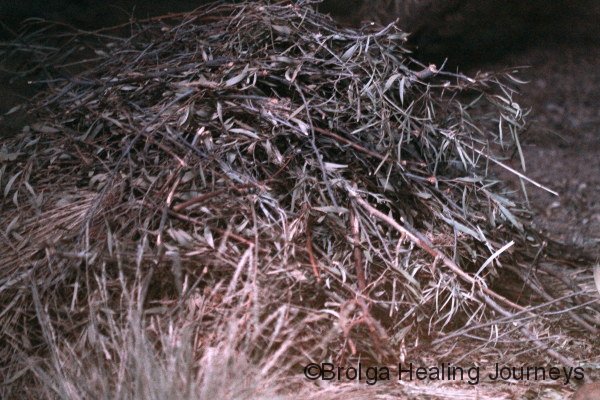
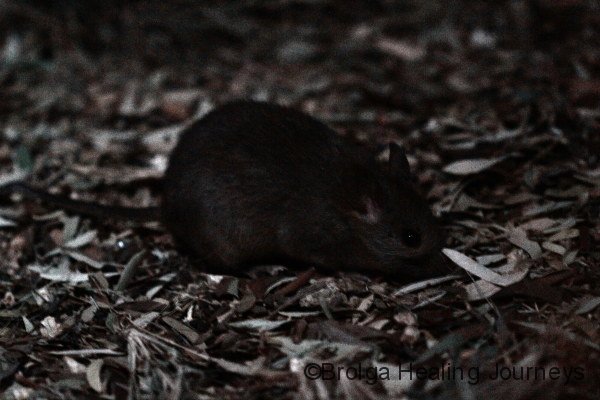
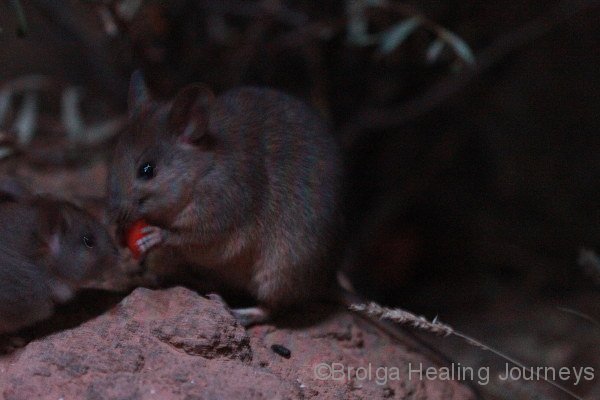
This unusual creature has a fittingly unusual name. The Greater Stick Nest Rat disappeared from the mainland in the 1930s and was believed to be extinct, until a few small populations were discovered on East and West Franklin islands off the coast of South Australia. The rat has since been released on a number of islands free from predators, and in enclosures in outback South Australia. The Alice Springs Desert Park also has a breeding program for the Greater Stick Nest Rat.
This rat gets its name from the amazing nests they build. Groups of up to 20 rats gather to construct nests by weaving and piling sticks and stones around a central nest of soft grass. The nests can reach up to 1.5 metres tall and just as wide. Over many generations the rats will add to, and renovate, their nests. Early settlers believed these nests to be piles of firewood collected by Aboriginals, thinking the rats to be purely opportunistic residents, never imagining that they were the engineers responsible for these elaborate constructions!
The nests once served to protect the Greater Stick Nest Rat from predators like the dingo and eagle, but were destroyed by hard-hoofed cattle and sheep brought in by European settlers. As a result, the exposed rats were easy prey for predators and their numbers plummeted.
There was once a Lesser Stick Nest Rat, but it is now extinct. Obviously it doesn’t pay to have ‘Lesser’ in your name if you are an Australian mammal.
The Greater Stick Nest Rat is somewhat larger than the Plains Rat, but is an equally attractive creature. It too is nocturnal and herbivorous.
The future of the Greater Stick Nest Rat would appear to be confined to safe islands and predator proof enclosures, supported by captive breeding programs, for the foreseeable future. While feral predators remain in large numbers on the mainland, and cattle and sheep grazing continue, there appears little likelihood of re-establishing the Greater Stick Nest Rat into the wilderness of the mainland.
THE SPINIFEX HOPPING MOUSE
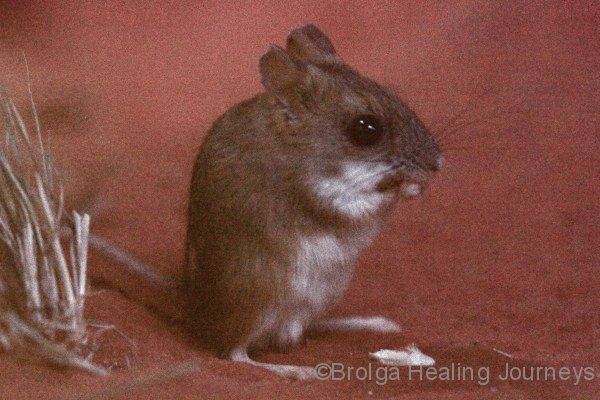
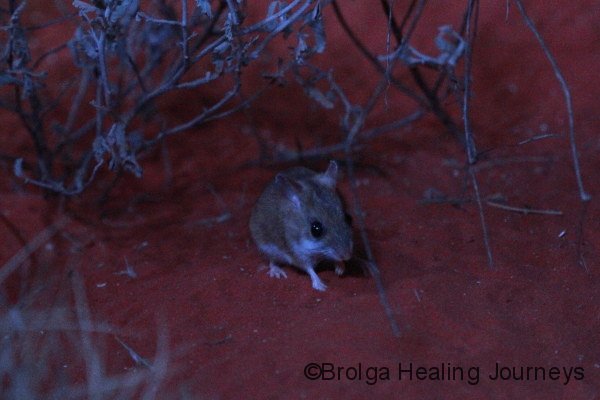
This pretty creature is another tiny placental mammal of the arid interior, and not surprisingly it lives in sandy, spinifex country. It is well adapted to our arid conditions, and is able to survive without drinking, satisfying its fluid requirements entirely from its food sources. It mainly eats seeds, eats and roots, but also eats insects, the latter most likely satisfying its fluid needs.
The Spinifex Hopping Mouse is not considered at risk nationally, though its numbers do fluctuate enormously depending upon conditions. It is most at risk from uncontrolled bushfires following inappropriate land management techniques.
ENDANGERED BIRDLIFE
Unfortunately, there is a long list of Australian birds classified as endangered, and many others are in population decline. Habitat destruction is the major problem, but also predation by feral cats. Here are a few species in detail:
THE GOULDIAN FINCH
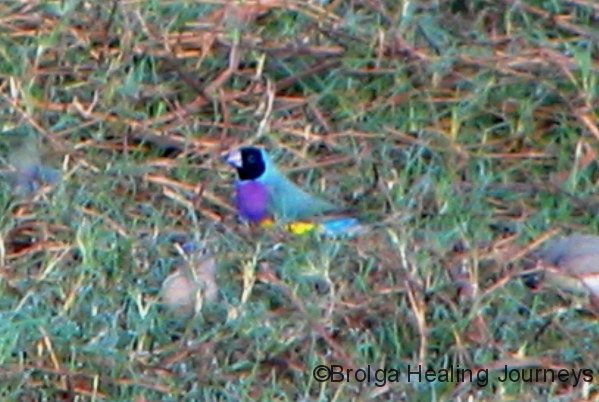
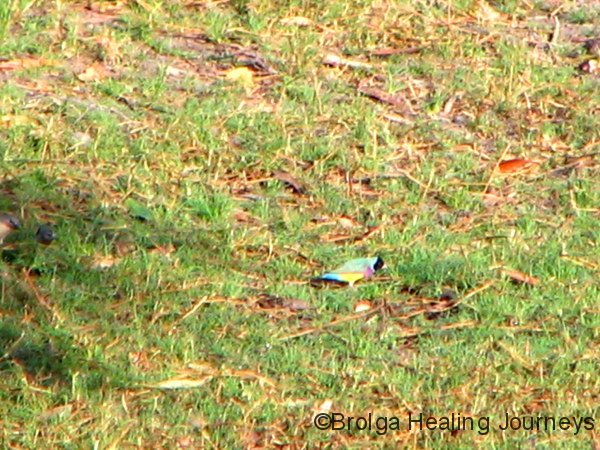
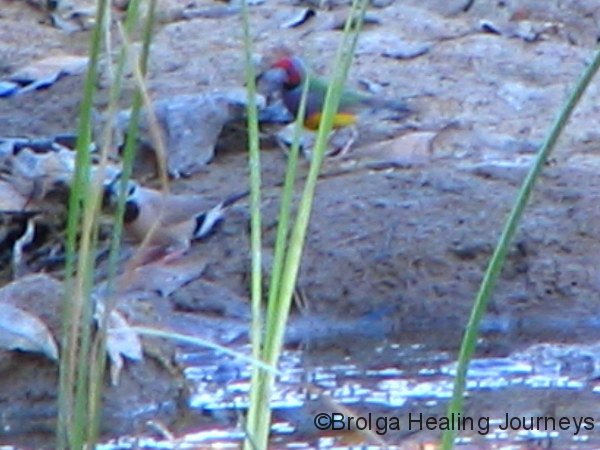
One of the highlights of our travels through the Kimberley region of Western Australia was our stay at the Mornington Wilderness Conservancy. This large property is one of many owned by the Australian Wildlife Conservancy around our country, each targetted at the long term preservation of endangered species. The Mornington property was purchased by the AWC to protect the beautiful, colourful Gouldian Finch and the Purple Crowned Fairy Wren, among other species.
Research into the plight of the Gouldian Finch provides an excellent example of the work AWC is doing at Mornington and beyond. Northern Australia once featured enormous flocks of these vibrantly coloured little birds, with reports of flocks in the thousands. But numbers have declined dramatically in recent decades. The Gouldian has disappeared altogether from large areas and when it is seen, it is now in small groups only; a flock of ten would be cause for celebration. The Kimberley remains the only part of the country where reasonable numbers are seen, but even there they are in worrying decline. It is estimated that Australia-wide there are only 2500 breeding pairs in the wild. Illegal trapping is partly to blame, with birds sold off as cage-pets. But the AWC has found that habitat destruction, and the restrictive behaviours of the Gouldian Finch itself, have conspired to endanger the species. The Gouldian Finch mainly eats grass seeds. Early in the dry season this consists of seeds from the tall sorghum grasses of northern Australia, but for a 6 week period at the end of the dry season, only the seed of the Spinifex grass is available and this comprises the food source of the Gouldian Finch. The Spinifex grass only sets seed in its third year. Research by the AWC found that most of northern Australia was being heavily burnt at least every second year. As a result, the spinifex grass was not reaching its third year in which it goes to seed, and thus the Gouldian Finch faced a six week period each season with little or no food. As a result, the finches would either die of starvation, choose not to breed, or breed and die of exhaustion trying to find food far from its nest. And to compound the problem, unlike other finches which choose a variety of nesting sites, the Gouldian Finch only nests in hollows in Snappy Gum trees, and these nests must be protected from other species seeking to secure the same nesting sites. So a common scenario is that a pair of Gouldian Finches finds a suitable nesting tree, fights to retain the nesting site, a fire passes through the area preventing the Spinifex from reaching a seed-bearing maturity, and the Gouldians fail to reproduce, at best trying again the following season, or at worst, dying in the attempt to find food.
But don’t despair, there is some light at the end of the tunnel! The AWC has found that a carefully managed burning program, in which some areas are burnt at the beginning of the dry season (ie very cool, controlled burns), and in which different regions are burnt in successive years, greatly reduces the incidence of destructive, widespread, uncontrolled late dry-season fires that wipe out so much of the Spinifex grass and with it the hope that the Gouldian Finch will reproduce. In recent years the AWC has managed the controlled cool burns across a huge area in the Kimberley, with the cooperation of many surrounding stations. The burn program is conducted by dropping a series of ping-pong balls filled with an incendiary mixture from a helicopter, across a carefully chosen path. They have found this program has protected the landscape from the effects of devastating fires and even better – the numbers of Gouldian Finch have improved in the region. Research by AWC into the haemoglobin levels of Gouldian Finches in the region show that these birds are also much healthier late in the dry season than they were several years ago, implying that food supplies are better. This greatly improves their chances of surviving and breeding.
This is one of many research programs being conducted by AWC into the Gouldian Finch, and other endangered species across Australia.
THE BROLGA
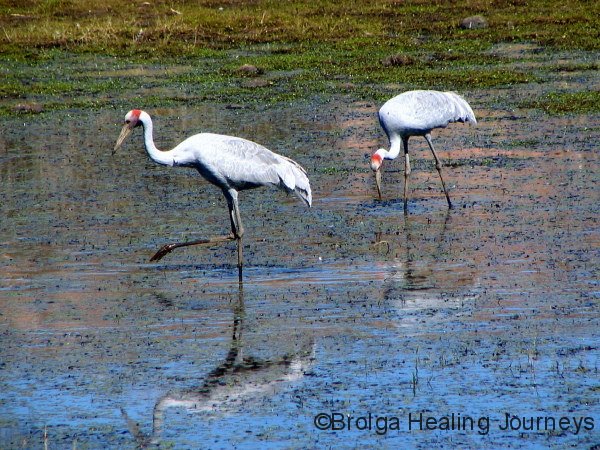
How could we possibly include the Brolga in a post concerning endangered wildlife? Surely they are everywhere!
Well, you will see plenty of Brolgas in some regions, notably in northern Australia, but the Brolga was once a common sight in south-eastern Australia as well. Unfortunately, as we have disturbed traditional wetland areas, either through spreading urbanisation or agricultural use, we have destroyed the habitat of this graceful bird. Climate change, if that leads to drier conditions, will compound this loss of habitat and see a further contraction of Brolga populations into the north of our country.
THE PINK (OR MAJOR MITCHELL’S) COCKATOO

This absolutely beautiful bird, with its pale pink body and red and yellow crest, is not faring well in Australia’s interior, its traditional habitat.
Unlike the Galah, which has thrived, the Pink Cockatoo has suffered enormously from land clearing for grazing and agriculture, which has greatly reduced native food plants for this species, as well as dramatically reducing its breeding sites. As a species the Pink Cockatoo requires extensive woodlands in order to support a viable population. During breeding, Pink Cockatoo pairs are fiercely territorial and will not tolerate others within several kilometers of their nesting site. With so few suitable nesting areas now available, the Pink Cockatoo is declining at an alarming rate in the wild. Trapping for illegal bird trade has exacerbated this decline.
The species is not currently listed as endangered nationally, but we believe that it will be before long. We have only seen this bird twice in three years of travel around Australia, much of which was in areas where the Pink Cockatoo would once have been a common sight.
THE ORANGE-BELLIED PARROT
The Orange-Bellied Parrot has been listed as critically endangered since 2005, and the latest estimates are that there remain only around 50 of these birds in the wild. Unfortunately, they are expected to become extinct in the wild within the next two to five years.
The Orange-Bellied Parrot breeds in Tasmania and lives most of the year there, but migrates across the Bass Strait to spend each winter on the south coast of the mainland. As if the annual journey to and from the mainland wasn’t challenge enough for these small parrots, the loss of salt-marsh habitat, essential to their winter feeding and survival on the mainland, is proving to be their death-knell.
The Australian Government recently allocated $260,000 to efforts to save the parrot, including providing supplementary food and nesting boxes in breeding areas, and also to undertake a captive breeding program. We only hope these efforts aren’t too late.
THE NIGHT PARROT
The thick-set Night Parrot of inland saltbush and spinifex country, is an almost mythical creature in birding circles. The last known specimen was found beside a road in outback Queensland in 1990, yet sightings of the Night Parrot are frequently reported from the outback, even as recently as June 2010 from the Pilbara.
As its name suggests, it is active at night, and is believed to emerge from its hiding place in spinifex and dense saltbush at dusk, to feed on seeds and grasses during the night. The nocturnal nature of the bird is what makes it so hard to find; approach it and it will fly away. People often report seeing the bird fly across remote roads during the night, but by the time they stop the car and get out to look, it is long gone.
Does the Night Parrot still live in the outback? Possibly, in remote desert regions of the Northern Territory and Western Australia. Its numbers would certainly have suffered from predation by feral cats and foxes, as it is sedentary during daylight hours. There is a nation-wide campaign to report sightings of the Night Parrot, but its remote habitat and nocturnal nature will make the bird difficult to find, if it is not already extinct.
WHAT IS ENDANGERING OUR WILDLIFE?
At the most basic level, simply look in the mirror to see the biggest danger to wildlife. Us! Okay, now I’ve got that out of my system, let’s look at the many and varied ways in which we have affected the natural environment in Australia, leading to extinctions of many species and placing more again under threat.
We can’t turn back the clock and wipe out these problems, but there are ways in which every single one of them can be addressed, if we have both the will and resources to do so.
HABITAT DESTRUCTION
Far and away the biggest problem facing Australia’s wildlife is the destruction of habitat, through widespread land clearing. It is estimated that since the arrival of white man, at least 70 per cent of our native trees and vegetation have been cleared. Obviously, such a wholesale destruction of vegetation has posed enormous problems for wildlife. The clearing of land has been most pronounced in the eastern states, so it should be no surprise to learn that it is there that wildlife has suffered most.
Clearing of native forest was undertaken to create grazing pastures, fields for crops and simply to obtain timber. Whilst the pace of land clearing has slowed, habitat destruction still occurs.
Problems such as increasing salinity in irrigation areas, changes to river flows through overuse of water resources upstream (the Murray-Darling basin is a perfect example), pollution, climate change, and the effects of bushfires, continue to place pressure on wildlife. We are all aware of the issues here, for they are reported regularly in the media. Entire Commonwealth Government departments and their State and Territory counterparts are looking for solutions to these problems, or at least ways in which to manage their impact upon the natural environment. The impact upon wildlife from these factors is enormous.
On the bushfire question, our native flora and fauna have adapted well to an environment where bushfires are commonplace. However, it would seem that the nature of bushfires has changed. The devastating bushfires of the Australian Capital Territory in 2003 and Victoria in 2009 provide examples. In both cases, I believe that a lack of cold season back-burning contributed to the ferocity and destructiveness of the fires. Certainly, in both cases, hellish weather conditions were the main factor behind the severity of the fires, but the high levels of fuel present in the regions compounded the damage. I know that in many areas of the bush surrounding Canberra virtually nothing survived the fires; the soil itself was incinerated. Climate change, if it leads to hotter, drier weather conditions in Australia, will only add to this problem.
The loss of traditional land management techniques in many areas of Australia has added to the bushfire problem. In many regions of Australia, the Aboriginal people employed ‘fire-stick burning’ in their traditional lands. These practices involved patch-work burning during the cooler months, limiting the damage caused by burning and allowing wildlife to move to adjacent regions which weren’t being burnt. Many species relied upon regenerating grasses to provide a succulent food source, and this practice increased biodiversity in the regions concerned.
Unfortunately, the dislocation of Aboriginal people from their lands and the disruption to their traditional practices led to a cessation of fire-stick burning in many regions. Much of this change occurred when Aboriginals were forced to move to Missions in central Australia, leaving their traditional lands and ceasing their land-management practices. It would seem then, that not only did these well-meaning Christians cause irreparable damage to the belief systems and ancient culture of the Aboriginal people of Australia by forcing them to worship their God, they also contributed in large part to the extinction of native species. There is also some evidence that the Aboriginal land practices were in decline even before the arrival of the Missionaries, as the diseases of white man – smallpox, measles and syphilis for example - had already spread across the country at an alarming rate and greatly disturbed Aboriginal culture.
As a consequence, some species, which were reliant upon that cycle of land-management, have suffered; indeed some, such as the Lesser Bilby, are now extinct. In other instances, as I have outlined above, uncontrolled bushfires now devastate huge areas that were once protected by the regular, controlled burning of smaller regions.
Surely this area of land management provides an example of where we could all benefit from traditional Aboriginal knowledge. Such an approach has been adopted by the Australian Wildlife Conservancy in the Kimberley area with great results. (More on that below.)
Fire, of course, is not the only problem. In many farming districts small patches of native vegetation have been left after clearing, in the belief that this will assist wildlife. This vegetation is certainly better than none at all, but in many cases the area covered is insufficient to provide habitat for many forest dwelling creatures. For example, where there is a relatively small distance from the open fields to the centre of the remnant vegetation, say, 30 metres, it is easy for predators such as Currawongs or Crows, not normally found in dense forest, to access prey that would otherwise have been safe in the original, deeper expanse of forest. This makes protection of larger areas of native vegetation in national parks and similar private ventures absolutely essential to the preservation of appropriate habitat for wildlife.
Another source of habitat destruction is the spread of our cities and towns. Obviously, increasing population leads to a greater demand for housing and to the spread of our urban areas into what was once wilderness. Short of a massive change to our behaviour, this will continue. What we can change however, is our approach to where we build. In too many instances, housing estates are being built by reclaiming wetlands for up-market canal estates. This was blatantly apparent to us in the region south of Perth. These wetland areas have been used for millennia by migratory birds for breeding and feeding. Unfortunately, the influence of property developers far exceeds that of the confused birds which arrive, by instinct, at their traditional breeding/feeding grounds only to find that powerboats and McMansions have sprung up in their stead. These birds cannot quickly adapt to these abrupt environmental changes, and fail to reproduce, in time dying out.
Similarly, many mangrove areas, which are absolutely crucial to the reproduction of a large number of marine species, have been destroyed in the name of canal estates and luxury recreational lifestyles.
Of course, we are not the only culprits here. For example, massive land reclamation activities in China along the coast of the Yellow Sea have caused a recent sharp decline in some species of wading birds reaching the Broome area of Western Australia.
FERAL PESTS
As if destroying the very habitat in which our wildlife lives was not enough, we have also introduced a huge array of feral animals into Australia to compound the problem.
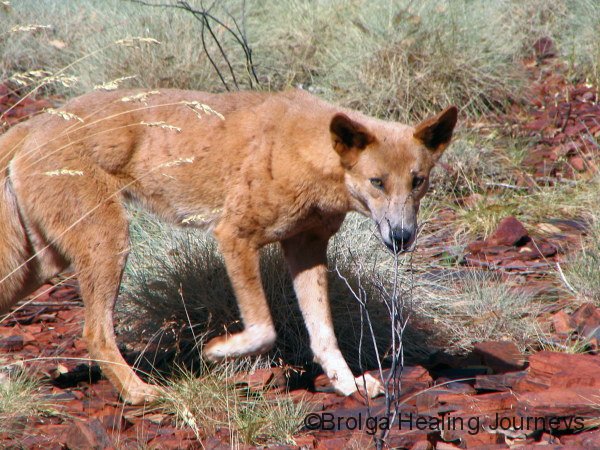
Interestingly, the first known feral animal to reach Australia was the dingo, but it has been here so long it is now referred to as a native animal. Nonetheless, the dingo had a significant impact upon native species as it spread across the land. It is believed to have played a role in the extinction of the Thylacine on the mainland, and in the decline of the Rufous Hare Wallaby in central Australia.
Since the arrival of the First Fleet from England, Australia’s non-aboriginal settlers have released many and varied species into the Australian wilderness. Some were released deliberately, others inadvertently. Unfortunately, all too many of them have had a devastating effect on our wildlife.
I’m sure we are aware of all of them. Nevertheless, I think it is useful to list them and explain their obvious, and sometimes not so obvious, effects on wildlife.
Feral Cats
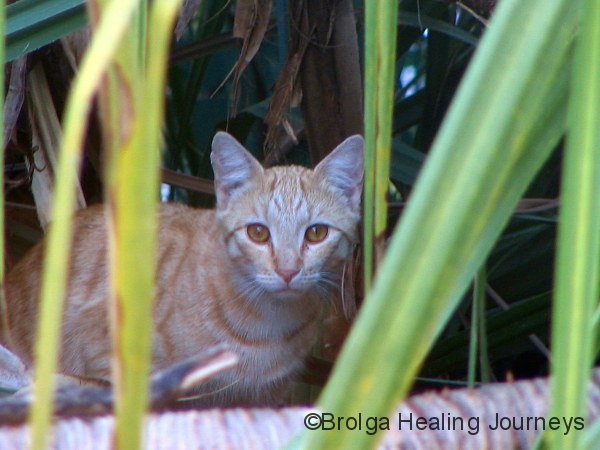
We are not cat haters, but believe they have no place in the Australian wilderness nor, in fact, uncontrolled in your backyard. We adore cats, marvelling at the elegance and the perfection of their movement. At one stage we supported five. I say ‘supported’ rather than ‘owned’, because one does not own a cat, the cat owns you. Unfortunately, as well as being a lovely pet, the cat is a magnificent, intelligent and adaptable predator. It has prospered in the wilderness of Australia, ranging far and wide across the country and reeking havoc upon our wildlife. It is estimated that around 12-20 million feral cats live across Australia, a frightening number. What is even more frightening is the estimate that in northern Australia alone, feral cats kill around 8 million native animals every single day. It is a miracle, really, that we have any wildlife left. Obviously, these cats have caused enormous damage to the populations of many small marsupials and birds.
As if that isn’t enough, feral cats are difficult to eradicate. They prefer their food fresh, so it is very difficult to control their numbers through poison baits, and this is made doubly so because they are suspicious creatures by nature; the difficulty of getting a domestic cat to swallow a tablet would have any cat owner nodding in agreement.
But all is not lost. There have been some recent improvements in the effectiveness of baits against feral cats. On a separate front, the Australian Wilderness Conservancy has found in its research that a healthy dingo population helps to control feral cat numbers, because dingoes either drive off or kill feral cats within their territory. Moreover, dingoes are less effective at killing birds and small marsupials, so they pose less of a threat to wildlife, and their presence tends to control cat numbers within a region. Given half a chance, populations of native species tend to improve, so it is not necessary to completely eradicate feral cats within an area. Nonetheless, feral cats will continue to pose an enormous challenge to native animals for many years to come.
Cat owners can help by having their pets de-sexed, and by installing cat runs in their yard, thereby protecting local birds from the ‘attentions’ of your pet.
European Foxes
The fox was released into Australia’s wilderness by British settlers who believed it would be a jolly good idea to be able to hold fox hunts in “their” new country, demonstrating, unfortunately, that animal cruelty migrates as easily as people. The fox has since spread far and wide across Australia. Like the feral cat, it has had a significant impact upon wildlife although it has been less damaging to birdlife, as the fox cannot climb trees. It does however pose a significant threat to medium sized animals, such as wallabies, and has caused serious declines in their numbers in many regions. The good news is that foxes are susceptible to poison baits (the ‘1080’ bait), and in some areas baiting has been so effective that endangered species have become re-established.
This has been the case in the Francois Peron National Park in Western Australia, near the famous Monkey Mia dolphin resort and Shark Bay. The national park is located on the Peron Peninsula, which is joined to the mainland by a relatively narrow isthmus. The Western Australian Government, through its Project Eden, has employed a combination of fencing and baiting of feral predators, to enable endangered species such as the Burrowing Bettong, the Brush-Tailed Bettong, the Bilby and the Malleefowl to be released into the wild. Populations of all these species are slowly becoming established in the national park. Unfortunately, releases of Rufous Hare Wallabies into the park were unsuccessful because they were wiped out by feral cats, which were then still a problem.
Feral Camels
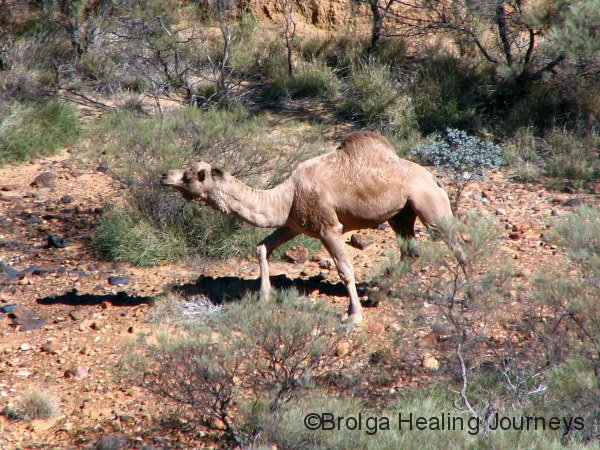
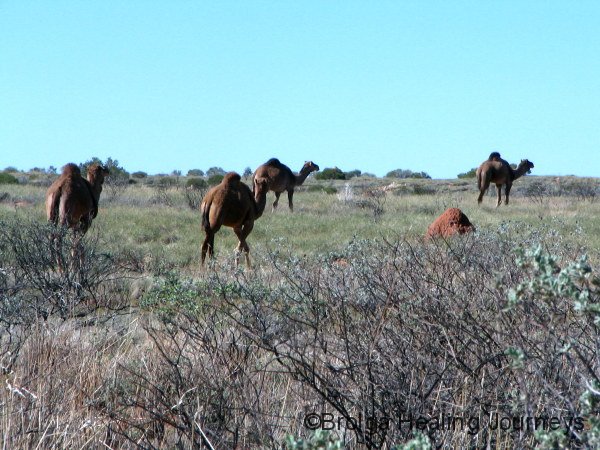
Camels were once crucial to transport across Australia’s arid interior. Some were released, while others escaped, and it is now estimated that there are 1 million feral camels across Australia, mainly in the Northern Territory and desert regions of Western Australia. Their numbers are estimated to double every nine years.
Camels are soft-footed creatures, so in that respect are less damaging to the environment than cattle and sheep. However, they have a wide diet, eating up to 80 percent of Australia’s inland plant species, so directly compete for food with native herbivores. Obviously they require a much greater quantity of food than native animals, and therefore put enormous pressure on inland eco-systems.
We tend to think of the camel as not needing much water, but a camel will drink up to 200 litres of water at one time when the opportunity presents. Multiply that by a herd of around 100 and a waterhole can be drained in no time at all. Camels also befoul the waterholes at which they drink.
They also damage clay-pan areas as they seek out water in dry times, and thus damage the habitat of many small native mammals, such as the Kultarr.
Camel-culling was undertaken in the Northern Territory in early 2010, and proved to be highly controversial. Some people are calling for camels to be exported as meat, or as live animals, because we have the healthiest camel populations worldwide. Perhaps some combination of all these methods will be needed to control their numbers. In any event, it would be difficult to catch camels for live export given the huge expanses on which they are found.
Rabbits
We all know the story of our feral rabbits and the various attempts to wipe them out. Poisons. Myxomatosis. Calicivirus. These approaches have all been tried with varied success. Whatever….the rabbits are still out there, in fact, around 200 million of them.
They eat native plants, and may have caused the extinction of some plant species. They also compete directly for food and habitat with many small herbivorous marsupials and mammals. And of course there is the enormous impact they have on crop production, though that is not the subject of this post.
Feral Goats
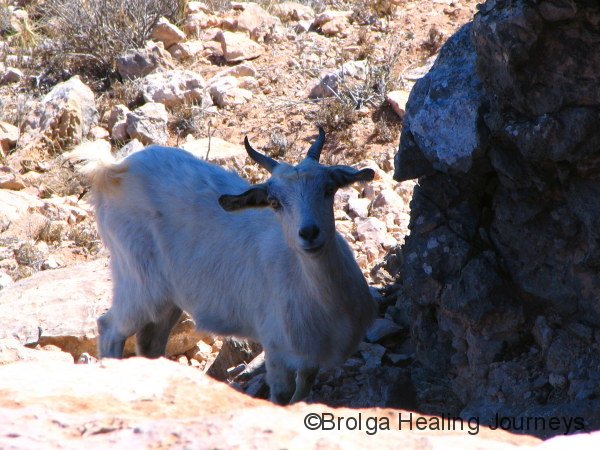
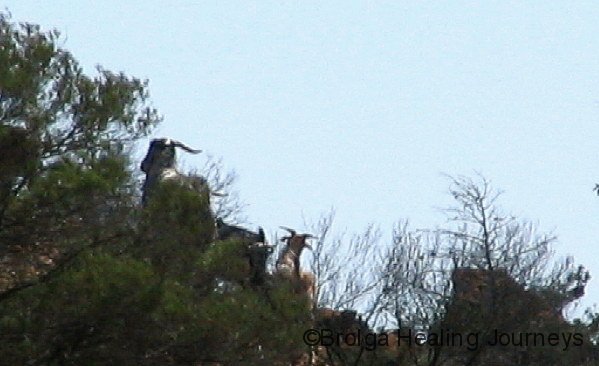
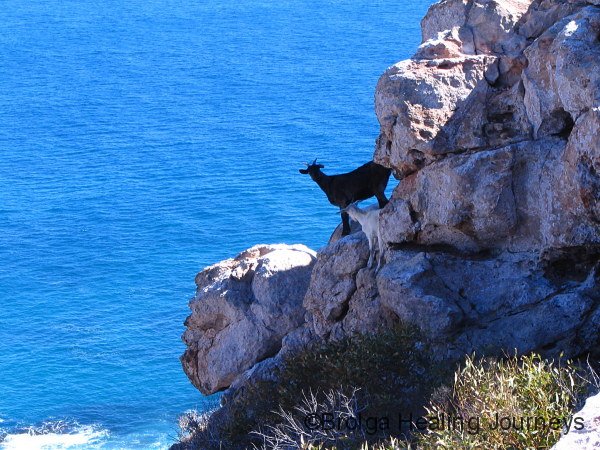
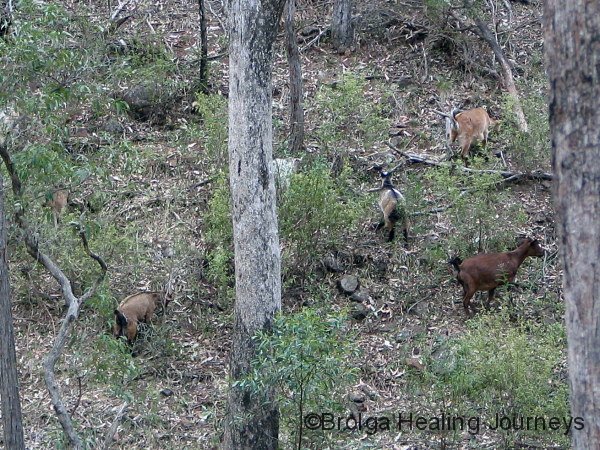
The goat may not the first creature to spring to mind when you think of feral pests. Even so, there are estimated to be 2.6 million feral goats across Australia. Their numbers are greatest in outback New South Wales and South Australia, and they are also in significant numbers in some areas of Western Australia.
Their competition for food has seriously impacted upon Rock Wallaby populations. Goats, as we all know, are nimble climbers, so have no trouble moving into rocky and hilly terrain normally inhabited by Rock Wallabies. They are also able to eat most native plants.
Efforts have been made to reduce their numbers through capture and sale as meat overseas. However, we were told by a Ranger at a NSW National Park that the licensed trappers of feral goats deliberately leave some populations intact so that they have an assured supply of feral goats from one year to the next.
Wild Pigs
Estimates of wild pig numbers vary widely – anywhere from 3 ½ million to 23 1/5 million – though either measure suggests they form a significant problem. They seriously damage native vegetation as the dig and rummage for food, especially along riparian eco-systems. This leads to increased soil erosion, an increased opportunity for weeds to become established in an area and for diseases such as die-back to take hold in native plant populations. Feral pigs also prey upon many small creatures, especially ground dwelling birds, and reptiles, adding to the pressures upon their numbers. Finally, as they wallow around in water holes to keep cool, they damage wetland areas.
Cane Toads
We all know about the inexorable march of the despised Cane Toad across northern Australia. This feral creature has spread from Queensland, across the top of the Northern Territory, recently crossing into the Kimberley region of Western Australia. It has also spread south from Queensland, possibly as far as Sydney. Because the territory of the Cane Toad is increasing so rapidly, it is very difficult to estimate their numbers. Nonetheless, a figure above 200 million seems reasonable.
The Cane Toad was first introduced onto sugar plantations in Queensland as a means of controlling two cane beetle species. The Cane Toads didn’t greatly influence beetle numbers, but as we know all too well, they became a far greater problem than the one they were brought in to control.
The Cane Toad secretes poison through glands on its skin and this is deadly to many native animals. As a result, numbers of native predators have suffered greatly in the areas into which the Cane Toad has spread. In some areas of the Northern Territory, populations of large reptiles such as Water Monitors have gone into serious decline following the arrival of the Cane Toad. Fortunately, not every creature that attempts to eat a Cane Toad is killed, and there is now some evidence to suggest that surviving animals learn to avoid the Cane Toad in future. As a result, populations of native predators such as reptiles and Quolls have stabilised in some areas.
The Cane Toad has other effects on wildlife; it is a carnivore and therefore preys upon small native mammals, invertebrates, reptiles and amphibians, and its competition for food and habitat with native animals of similar size and habitat puts pressure on their populations.
Cattle and Sheep
To be honest, I’m not sure that we need to separate feral cattle and sheep from those on grazing properties, when examining their effects on wildlife. This comment would not please grazing interests, but so be it. These hard-footed (or hoofed) animals cause considerable damage to our native soils and habitat as they move around the land, putting pressure on small mammals and marsupials. They also damage the country around waterholes and compete with herbivorous wildlife for food. Widespread clearing of land for grazing since the arrival of white settlers, particularly in the eastern states, has had an enormous impact upon wildlife which once lived in the forests in those regions, particularly birds, small mammals and reptiles.
Interestingly, the Kangaroo, another grazing animal, has been one native animal to benefit from this land-clearing. The Kangaroo has thrived in the same country as cattle and sheep, also benefitting from graziers’ efforts to supply permanent water for cattle and sheep. Kangaroo numbers have boomed so much in the eastern states that overpopulation is now a problem, and culling has been carried out. A culling program in the Australian Capital Territory has received international media attention. It is a controversial and complex issue. In her wildlife blog, our friend Carly Wilson has a recent post examining the many facets of the culling issue. Her post can be reached by clicking on the following link:
http://carlywilson.com/2010/07/to-cull-or-not-to-cull/
Other Feral Animals
The list goes on. In many cases, whilst many feral animals do not prey upon our wildlife, their competition for food and territory place pressure on already struggling native populations. In the case of feral birds such as the Common (or Indian) Myna, their aggressive nesting habits drive out native competition. Moreover, many feral animals have thrived through the lack of natural predators in the Australian environment.
Some common other feral animals include the European carp, the Spotted Turtle Dove, the Sparrow, the Starling, the Blackbird, the Pigeon, wild dogs, and wild horses (brumbies) of which there are an estimated 300,000 in the wild. In the insect world, the European Wasp and the Fire Ant come to mind.
Unfortunately, I’m sure there are many feral species I have missed!
NOXIOUS WEEDS AND GRASSES
These plants may not directly impact upon wildlife, but are more likely to impact upon native plant species by invading their habitat. Of course, to the extent that wildlife is dependent upon native plant species for food or habitat, the invasion of an environment by a noxious weed could place pressure on wildlife populations.
Some noxious weeds include the Blackberry (a huge problem along creek-beds in eastern Australia), the White Willow (ditto!), Lantana, the Prickly Pear, St John’s Wort, and the many and varied noxious species of grass found across the country.
OTHER FACTORS
As you can see, we have given our wildlife an enormous challenge through the species we have introduced into Australia. Unfortunately, there are still other human-related factors affecting our wildlife. Some of those are:
Traffic
Drive along any major road in Australia and you will see ‘road kill’ a euphemism for native creatures slaughtered by our cars and trucks. In some areas, such as the Nullarbor Plain, and even in Canberra, the number of kangaroo bodies lining the roads is sickening.
One of the major killers of wildlife on our highways is the road train. These often travel overnight when many native animals are active. And road trains are unable and/or their drivers unwilling to avoid wildlife. While working in Carnarvon we heard of several instances where entire Emu families were killed as they crossed the highway by a road train, which continued along the road as if nothing had happened. Drivers in following cars stopped and were appalled by the carnage.
There is no obvious answer to this. Certainly, less pressure on road trains to travel overnight to reach their destinations would help. Similarly, car drivers should avoid night-time driving in regions with plentiful wildlife. And of course, the obvious solution – slow down! Before I am accused of stating the bleedin’ obvious, let me illustrate this last point. We had two wonderful stays in the Cape Range National Park, adjacent to the Ningaloo Reef in the Exmouth region of Western Australia. Cape Range is full of wildlife, and Western Grey Kangaroos and Emus are frequently seen near the road. The national park forms a long narrow strip adjacent to the coast, and a single bitumen road travels the length of the park, with dirt tracks leading off to camping grounds and sites of interest. Despite there being obvious and abundant wildlife near the road – we were in a national park, for goodness sake - it is lined with the bodies of unfortunate victims, because drivers simply do not slow down in the park, preferring to thunder along the road as if it was a freeway. Unfortunately, the over-stretched resources of the national park do not extend to policing its roads, so it is left to the common sense of drivers to behave appropriately. Enough said! Perhaps a solution would be to install speed bumps along the road, but you can just imagine the outcry from people eager to see the entire national park in record time on their rushed holiday.
In some countries, such as Canada, overpasses have been built to enable wildlife to safely travel across the top of highways. In Australia, this could have some use in narrow, known crossing areas, for example where a road passes through an area of forest. However, given the huge distances involved with our road system, it would not be feasible on a larger scale.
Hunting/Trapping
The Thylacine (Tasmanian Tiger) was hunted to extinction in Tasmania. Other species, such as the Gouldian Finch, are endangered for many reasons, one of which is trapping for live sale.
Duck shooting is still permitted in some states, despite a wealth of evidence that numbers of migratory birds are in serious decline worldwide. Habitat destruction is the major cause for this decline, but let’s not compound the problem by allowing these birds to be killed for sport.
POSITIVE DEVELOPMENTS & HOW YOU CAN HELP
If you have read this far, please don’t be filled with despair. At last, it is time for some good news. There are many individuals and organizations in Australia dedicated to the survival of our endangered wildlife. Many work in captive breeding programs, others in the areas of habitat conservation and renewal. There are far too many people and organizations involved to detail them all here, but I will briefly discuss a few. I would like to apologise to those I have not mentioned, for everyone involved in this area deserves acclaim.
At the Government level, the various National Park and Wildlife services work tirelessly, often with limited resources, to protect many endangered species. Research undertaken by these agencies is crucial to our understanding of the challenges facing wildlife and also to monitoring population levels.
Unfortunately, in our profit-driven society, wildlife and wilderness are considered less important than industry and development, and also less important than our human needs. Governments reflect our wider societal values, with the result that wildlife and conservation are allocated far fewer resources than they need.
Some inspired private sector individuals recognised this shortfall and have stepped in to ‘do their bit’.
AUSTRALIAN WILDERNESS CONSERVANCY (AWC)
The AWC was founded by Perth businessman Martin Copley, who realised that the crisis facing Australia’s wildlife and wilderness areas was something that Governments alone were unable to manage. As a result, he purchased a property containing wilderness south of Perth, and the AWC was underway. Since then, the AWC has grown into a remarkable organisation, now owning extensive properties in many key wilderness areas around the country. It is a private, non-profit organisation that relies upon our support.
In their own words, the:
- AWC acquires land, and works with other landholders, to establish sanctuaries for the conservation of threatened wildlife and ecosystems. AWC now owns 20 sanctuaries covering 2.5 million ha (6.2 million acres) in places such as north Queensland, the Kimberley, western New South Wales, Northern Territory and the forests of south western Australia.
- AWC aims to ensure that its sanctuaries act as ‘catalysts’ for broader landscape scale conservation efforts. Accordingly, AWC works closely with its neighbours to also promote conservation beyond the borders of each AWC sanctuary.
We have witnessed first hand the wonderful work being done by the AWC in the Kimberley region, and look forward to visiting further AWC properties in future, and to assist them with their work. Among the many tremendous things they have achieved, the AWC has established an 8000 hectare (20000 acre) fenced enclosure, fully protected from feral predators, at their Scotia sanctuary in NSW,in which many endangered species now have a chance to re-populate. I had no idea just how large an area 8000 hectares is, so I did a calulation, and worked out that if the area was square, each side would be just under 9km long. This is a remarkable achievement by any measure. In the words of Sir David Attenborough: “Six of the world’s rarest mammals can be brought back from the edge of extinction by helping AWC’s project at Scotia. It is a vitally important project for Australia and the planet.”
If you are wondering how on earth to help to protect our wildlife, but don’t have the time to do anything yourself, you could do no better than provide financial support to the AWC, however modest. Please check out their website and make a donation!
http://www.australianwildlife.org/
BUSH HERITAGE AUSTRALIA
Another inspirational organisation, this was founded in 1991 by Dr Bob Brown, now leader of the Australian Greens Party, when he moved heaven and earth to purchase two magnificent forest reserves in Tasmania otherwise destined for woodchipping. Since then, Bush Heritage has purchased many key bush properties around Australia in order to protect endangered habitat and species. Chris Darwin, the Great Great Grandson of Charles Darwin, is a prominent supporter of this organisation, and regards his involvement with them as the greatest thing he has ever done.
Bush Heritage Australia relies upon our support to fund their activities. Please visit their website to learn about the wonderful work they do.
http://www.bushheritage.org.au
BIRDS AUSTRALIA
Our first encounter with Birds Australia was at their Broome Bird Observatory, a remarkable and inspiring place.
In their own words, this is what Birds Australia is all about:
“There are almost as many types of people who are into birds as there are birds themselves. There are scientists who study them, observers who watch them, twitchers who chase after them, conservationists who want to protect them and members of the general public who just like having birds in their lives.
What these diverse groups have in common is Birds Australia.
Since 1901, Birds Australia (formerly the Royal Australasian Ornithologists Union) has been bringing together people who care about birds. More than just a research organisation, BA is a passionate advocate for the protection of our birds and the habitats on which they depend.
As Australia’s birds face unprecedented challenges to their survival- habitat destruction, feral predators, climate change- Birds Australia is in there, working with the broader Australian community to speak out on behalf of our amazing birdlife.”
If, like us, you love Australian birds, we urge you to join Birds Australia. Your support will assist BA research into the challenges facing our birdlife, and their work to save our endangered bird species.
Check out their website:
http://www.birdsaustralia.com.au/
STEVE IRWIN WILDLIFE CONSERVATION/WILDLIFE WARRIORS WORLDWIDE
Not everyone loved the presentation style of the late Steve Irwin, but no-one could dispute his love of wildlife and the wonderful work he did to make people, and in particular children, aware of the natural world.
Steve Irwin was definitely a man of action, and he invested most of the proceeds from his television shows into the conservation of wilderness areas and wildlife in Australia.
You can learn more about the wonderful work begun by Steve Irwin, and continued by his family, by visiting the following website. Make a donation to make a difference!
http://www.australiazoo.com.au/conservation/wildlife-warriors/
MALCOLM DOUGLAS
Many of us know Malcolm Douglas from our television screens, as a true Aussie character bringing the Kimberley to our lounge-rooms. What we may not know is that Malcolm Douglas also runs a Wilderness Park near Broome, which is involved in protecting Australian wildlife and in captive breeding programs of endangered species.
Visit Malcolm’s website, and when you are next in the Broome region visit his park.
http://www.malcolmdouglas.com.au/
FOOTNOTE: We were very sad to learn of the death of Malcolm Douglas on 23 September 2010. Malcolm was killed in a car accident on his Broome property. The world has lost another wildlife warrior. We are sure the Bilbies are crying.
OTHER ORGANISATIONS
This list of worthwhile organizations is long, and we cannot support them all. You may prefer to support the WWF or Greenpeace, which have a global focus.
WHAT CAN I DO AT HOME?
Aside from providing financial support to organisations working to save our wildlife, we can all make a difference in our own back yards.
We can help by planting native shrubs and bird-friendly gardens. Choose plants which provide lots of ground cover, for example in the form of prostrate grevilleas, as they protect small birds, such as the Fairy Wrens, which are quickly disappearing from our urban areas.
If you own cats, please install a cat run. Unfortunately, nothing removes native birds from your garden quite as efficiently as your pet cat. These runs are relatively inexpensive and give your pet the opportunity to go outside, while protecting wildlife. And unless you are a registered breeder, please have your cat desexed. We already have 12 million feral cats in Australia – let’s not add to the number.
If you have the time, you can volunteer locally to remove noxious weeds from the environment, or to replant native trees in the area. You could even train to become a wildlife carer, helping to rehabilitate injured wildlife for return to the wild, or to raise orphaned wildlife for release. Every little thing makes a difference.
And finally, if you are a parent, try to inspire in your children a love of wildlife. Our children, after all, are the future of our wildlife.
References/acknowledgements
As well as our own travel experiences, I have drawn on material from a number of sources for this post. The following books and magazines have provided material on some of the endangered species discussed above:
Field Guide to the Birds of Australia, by Simpson and Day
Reader’s Digest Complete Book of Australian Birds
Brolga Country, Travels in Wild Australia, by Mitch Reardon
A Field Guide to Central Australia, by Penny van Ooosterzee
Cronin’s Key Guide to Australian Mammals
Wildlife Matters – a magazine published by the Australian Wildlife Conservancy
I would also like to acknowledge the staff of the Alice Springs Desert Park for the information, both written and verbal, they have provided. In particular, I would like to single out Pam, an animal-behaviour specialist, and guide at the park, who has been a veritable font of knowledge on all matters discussed in this post. Pam has been gracious in answering the many questions I have thrown her way. When you are in Alice Springs, visit the Desert Park and be inspired. In the words of our wildlife guru Sir David Attenborough “there is no museum or wildlife park in the world that could match it”.












